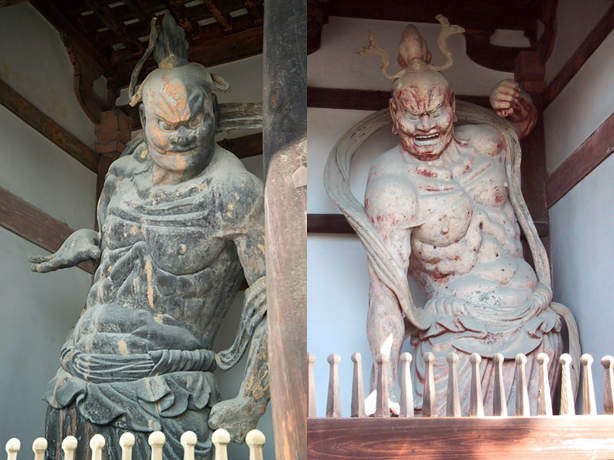
Kongo-rikishi statues at the gate of Horyuji Temple
Some thoughts on breathing in Aikido training.
The Kongo-rikishi statues that guard the gate to the inner sanctum of Horyuji Temple are the oldest in Japan. These “Guardian Kings” were said to have traveled with Shakyamuni Buddha, in order to act as his bodyguards.
The one one the right (Misshaku Kongo) has his mouth open in the first letter of the Sanskrit alphabet (“A”). The one on the left (Naraen Kongo) has his mouth closed, representing the last letter of the Sanskrit alphabet (“un”).
“A-un” is generally used to represent the breadth of existence – the universe existing between the combined In-Yo opposites.
In the west this is sometimes pronounced as the Indian “Om” or “Aum”.
In China this is associated with Heng-Ha breathing exercises in the practice of…martial arts. There the statues are called the Heng Ha Er Jiang (哼哈二将, the two generals Heng and Ha).
Getting back to Aikido – here’s a short tidbit from Aikido Founder Morihei Ueshiba:
武産の武の阿吽の呼吸の理念力
The martial art of Takemusu is the power of the principle of A-un breathing (kokyu)
Seems pretty important!
Then we have Gozo Shioda, who said that “Ueshiba sensei was always talking about breath power, breath power (kokyu-ryoku)”.
Now, let’s get back to the section that we examined in “Aikido and the Floating Bridge of Heaven“:
合気道は「天の浮橋に立たされて」ということである。天の浮橋は水火結んでめぐるということ。火は水を動かし、水は火によって動かさる。火も水も一つのものである。螺旋状にめぐる。気をもって絡むのである。それは、息によるものであり、この息が合気であります。
It is said that Aikido is “Standing on the Floating Bridge of Heaven”. The Floating Bridge of Heaven is the turning of fire and water bound together. Fire moves water, water is moved by fire. Fire and water are one thing. They turn in a spiral. They are entwined through Ki. That is something that is enacted through the breath (“iki”). This breath (“iki”) is Aiki.
Note the last sentence: That is something that is enacted through the breath (“iki”). This breath (“iki”) is Aiki.
There’s a lot of talk about breathing in Aikido – breath power (kokyu-ryoku), breath method (kokyu-ho), breath throw (kokyu-nage), and so on.
There’s even a section in “Aiki Shinzui” (a collection of essays by Morihei Ueshiba) called 合気は息の妙用なり (“Aiki is the mysterious working of Iki (breath).”).
There’s that word again – “iki”.
Ueshiba, of course, used “Kokyu” when speaking about the breath. However, he would just as often (perhaps even more often) use the word “iki”.
In “Takemusu Aiki” the word “Kokyu” is actually annotated in many places to be pronounced, phonetically, “iki”.
So where does “iki” come from? Here’s a quick hint:
合気道の呼吸法によるイキ(息)は、右に螺旋して舞い昇り、左に螺旋して舞い下り、水火のムスビ(産霊・結び)が生ずる。
The “Iki” (breath) of Aikido’s kokyu-ho winds up in a spiral on the right, winds down in a spiral on the left, and gives rise to the connection between Water (“I”) and Fire (“ki”).
Once again, we see those very interesting spirals that we discussed a little bit in “Aikido and the Floating Bridge of Heaven” and “Morihei Ueshiba, Budo and Kamae“.
Also, we see that “Iki” is a combination of the opposing In-Yo forces of Water and Fire to make the mnemonic phrase “Iki”, which also means “breath”.
Fire and water, representing opposing In-Yo forces, don’t just make an appearance in the breath, here’s an interesting segment by Morihei Ueshiba, originally published in the July 1978 issue of the Aikido Mansei News (Issue #51):
一口に神ということは、合氣ということになる。
何故合氣ということになるかというと、火と水でカミになるからです。
このカミつまり火と水の根源は、元の一元に帰るが、一元から霊魂の源、物質の源が生まれたのです。
この火と水をもって、この世界を造っている。
だからこの世界は火と水によって形成されている。
In one word, God (“Kami”) becomes Aiki.
The reason why it becomes Aiki is because Fire (“Ka”) and Water (“mi”) becomes “Kami” (“God”).
This Kami (in other words the source of Fire and Water), when we return to the beginning, from the One the source of the Spirit and the source of the Physical are created,
This structure of this world is made with this Fire and Water.
Therefore this world is formed by Fire and Water.
Above, Ueshiba explains, in an uncharacteristically clear fashion. Actually this is a straight up rephrasing of Chinese cosmology right out of the Taoist tradition, in which the One becomes two opposing In-Yo forces, which then form the 10,000 things.
Ueshiba says here that all things flow from the Kami, from the gods – but also says that he is actually pointing to the traditional cosmology in which all things flow from the interaction of the two opposing In-Yo forces.
Now, before the peanut gallery comes out – no, I’m not saying that Morihei Ueshiba did not believe in the Shinto Kami.
What I am saying is that it is important to look at phrases like “Aikido comes from God” very closely in order to ascertain what he is saying with regards to technical methodology.
In my opinion, if one were, for example, to become a follower of Omoto-kyo in order to enhance their martial training (something that Ueshiba himself discouraged, by the way), that it would likely not be all that productive in martial terms.
Here we see the explanation expanded a little bit:
火水(かみ)というのは体(物事の中心)であり、水火(いき)とは用(働き)であります。
Fire and Water (“Ka”+”mi”) is the body (the center of the physical), Water and Fire (“I”+”ki”) is the usage (action).
Here we see that Ueshiba has connected the two mnemonic phrases – Fire and Water combined to form “Kami” and Water and Fire combined to form “Iki”.
With this statement it is made clear that, for Ueshiba, the structure of the universe springs from opposed In-Yo forces – and that those structural In-Yo forces are manipulated through the In-Yo forces embodied in the breath.
Looking a little deeper into what he was talking about when he said “breath”, here is a bit from “Takemusu Aiki”, page 134:
天の呼吸、地の呼吸(潮の干満)を腹中に胎蔵する。
Nurture the breath of heaven and the breath of earth (the tides) in the center of your abdomen.
(*Ueshiba actually uses the Buddhist Womb Realm (“Taizo-kai”) for “nurture” above.)
Ueshiba also called the “breath of heaven” the “breath of the sun and moon”, and assigned it a vertical component. He called the “breath of earth” the “breath of the tides” and assigned it a horizontal component. The two types of breathing formed a cross.
The cross, by the way, is also important – so important that Ueshiba would sometimes write “Aikido” as “Aikiju” (the “Aiki-cross”), but more on that another day.
We can also see from further down below (and in other places where it’s written the same way) that the two types of breathing combined become “iki”.
Now, when he wrote “iki” (which is a single Kanji character) he would often write it in an interesting way, with two Katakana characters – “i” and “ki” – annotating two hand drawn symbols. “I” would be replaced by a circle containing 4 lines (dividing it into eight sections) and “ki” would be replaced by a square divided in the same manner.

Traditional Aikido Volume 5
In the above section from “Traditional Aikido Volume 5: Training Works Wonders, by Morihiro Saito”, we see Morihiro Saito saying, “The Founder also explained the combination of the Triangle-Circle-Square as (I) (ki) (breath), that form the root of science.”.
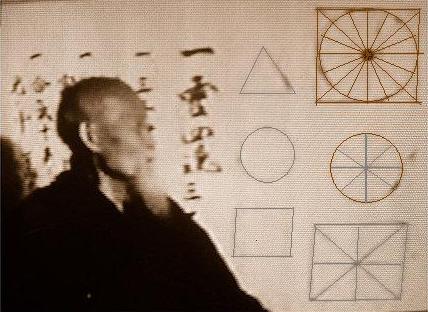
Morihei Ueshiba Lectures – note the diagrams
Also from Takemusu Aiki page 134:
はく息は (divided circle) である。ひく息は (divided square) である。腹中に (divided square) を収め、自己の呼吸によって (divided circle) を (divided square) の上に収めるのです。
理の呼吸につれて、呼吸をつくり、技の姿もかくの如く出てくるのです。
Exhaling is the (divided circle). Inhaling is the (divided square). Store the (divided square) in your abdomen, and add the (divided circle) to the storarge through your own breathing”.
According to this principle of Kokyu, create breath (Kokyu), and the form of the technique will emerge in just this way.
In Ueshiba’s cosmology, the circle represents Heaven, the square represents Earth, so we have the breath of heaven and the breath of earth in a cross with the breathing maintaining pressure along the cross in the balance of in and yo. The balance of in and yo can be seen in the 4 lines that divide each symbol, which represent the 8 powers.
The 8 powers, which are the balanced opposing forces of in and yo, were described by Morihei Ueshiba in an article in the Aikido Shimbun published on February 10th 1974:
八力は、対照力「動、静、解、凝、引、弛、合、分、」「9-1、8-2、7-3、6-4」をいいます。
The 8 powers are opposing forces: Movement – Stillness, Melting – Congealing, Pulling – Loosening, Combining – Splitting / 9-1, 8-2, 7-3, 6-4
See “Aikido without Peace or Harmony” for a more detailed discussion of the 8 powers.
Still don’t know how to breath? Don’t be surprised, breath training is a complex and somewhat delicate task – most traditions place it somewhere among the more advanced training in their pedagogical structure.
“How to do” would be a more daunting task than I’m willing to take on over the internet, so if that’s what you’re looking for then you’re going to be disappointed.
I’m really just going to point towards some of the deeper meanings layered in Morihei Ueshiba’s writings and hope that some people will be interested enough to follow through in their own training.
With that in mind – I hope you found the above interesting.
Christopher Li – Honolulu, HI

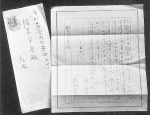
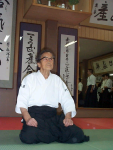
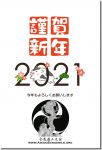

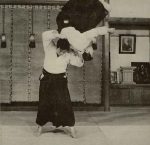
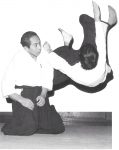
Leave a Reply